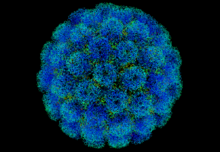Simian virus 40
| Simian virus 40 | |
|---|---|
 |
|
| Virus classification | |
| Group: | Group I (dsDNA) |
| Family: | Polyomaviridae |
| Genus: | Polyomavirus |
| Species: | Simian virus 40 |
| SV40 | |
|---|---|
| Classification and external resources | |
| MeSH | D027601 |
SV40 is an abbreviation for Simian vacuolating virus 40 or Simian virus 40, a polyomavirus that is found in both monkeys and humans. It was named for the effect it produced on infected green monkey cells, which developed an unusual number of vacuoles. Like other polyomaviruses, SV40 is a DNA virus that has the potential to cause tumors in animals, but most often persists as a latent infection.
The discovery of SV40 revealed that between 1955 and 1963 around 90% of children and 60% of adults in USA were inoculated with SV40-contaminated polio vaccines.
SV40 was first identified by Ben Sweet and Maurice Hilleman in 1960 when they found that between 10-30% of polio vaccines in the USA were contaminated with SV40. In 1962, Bernice Eddy described the SV40 oncogenic function inducing sarcoma and ependymomas in hamsters inoculated with monkeys cells infected with SV40. The complete viral genome was sequenced by Fiers and his team at the University of Ghent (Belgium) in 1978.
SV40 consists of an unenveloped icosahedral virion with a closed circular dsDNA genome of 5.2 kb. The virion adheres to cell surface receptors of MHC class I by the virion glycoprotein VP1. Penetration into the cell is through a caveolin vesicle. Inside the cell nucleus, the cellular RNA polymerase II acts to promote early gene expression. This results in an mRNA that is spliced into two segments. The small and large T antigens result from this. The large T antigen has two functions: 5% goes to the plasma cell membrane and 95% returns to the nucleus. Once in the nucleus the large T antigen binds three viral DNA sites, I, II and III. Binding of sites I and II autoregulates early RNA synthesis. Binding to site II takes place in each cell cycle. Binding site I initiates DNA replication at the origin of replication. Early transcription gives two spliced RNAs that are both 19s. Late transcription gives both a longer 16s, which synthesizes the major viral capsid protein VP1; and the smaller 19s, which gives VP2 and VP3 through leaky scanning. All of the proteins, besides the 5% of large T, return to the nucleus because assembly of the viral particle happens there. Eventual release of the viral particles is cytolytic and results in cell death.
...
Wikipedia
